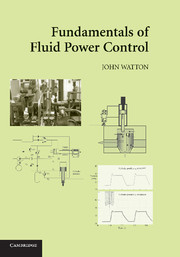5 - System Dynamics
Published online by Cambridge University Press: 05 June 2012
Summary
Introduction
The preceding chapters considered the steady-state behavior of common fluid power elements and systems. In reality, fluid power systems handle significant moving masses, and the combination of this with fluid compressibility results in system dynamics that usually cannot be neglected. In addition, individual components such as PRVs require a finite time to accommodate flow-rate changes. This also applies, for example, to a servovalve that again requires a finite time to change its spool position in response to a change in applied current. The combination of these issues means that the design of both open-loop and closed-loop control systems must take into account these dynamic issues. In particular, a closed-loop control system will almost certainly become unstable as system gains are increased because of such dynamic effects. Instability can lead to disastrous consequences if severe pressure oscillations occur. Instability in axial piston motor speed control systems, for example, can result in severe repetitive lifting and impact of the pistons on the swash plate.
Consider the design of a servoactuator that forms one of four to be used to provide the “road” input to the wheels of a vehicle sitting on a rig commonly called a “four-poster.” Figure 5.1 shows one of the servoactuators and a block diagram of the position control system.
Determining the dynamic performance of the position control system only is relatively straightforward once the important dynamic features have been identified.
- Type
- Chapter
- Information
- Fundamentals of Fluid Power Control , pp. 209 - 322Publisher: Cambridge University PressPrint publication year: 2009



